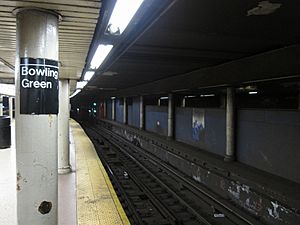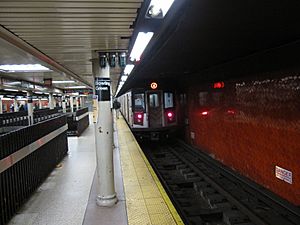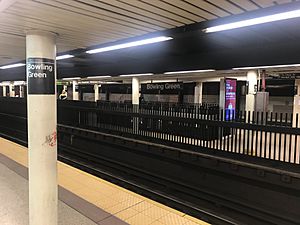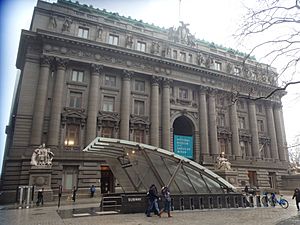Bowling Green station facts for kids
Quick facts for kids
Bowling Green
|
|||||||||||||
|---|---|---|---|---|---|---|---|---|---|---|---|---|---|

Platform for trains going to Brooklyn (right)
|
|||||||||||||
| Station statistics | |||||||||||||
| Address | Battery Place & Broadway New York, NY 10004 |
||||||||||||
| Borough | Manhattan | ||||||||||||
| Locale | Financial District | ||||||||||||
| Coordinates | 40°42′15″N 74°00′52″W / 40.70417°N 74.01444°W | ||||||||||||
| Division | A (IRT) | ||||||||||||
| Line | IRT Lexington Avenue Line | ||||||||||||
| Services | 4 alltimes (all times) 5 allexceptnights (all except late nights) |
||||||||||||
| Transit connections | |||||||||||||
| Structure | Underground | ||||||||||||
| Platforms | 1 side platform 2 island platforms (1 in use, 1 abandoned) |
||||||||||||
| Tracks | 2 | ||||||||||||
| Other information | |||||||||||||
| Opened | July 10, 1905 | ||||||||||||
| Station code | 414 | ||||||||||||
| Accessible | |||||||||||||
| Opposite-direction transfer available | Yes | ||||||||||||
| Traffic | |||||||||||||
| Passengers (2019) | 8,362,034 |
||||||||||||
| Rank | 39 out of 425 | ||||||||||||
| Station succession | |||||||||||||
| Next north | Wall Street: 4 alltimes 5 allexceptnights | ||||||||||||
| Next south | Borough Hall: 4 alltimes 5 weekdaysonly (Terminal): 5 weekendsonly South Ferry (loops; closed): no service |
||||||||||||
|
|||||||||||||
|
|||||||||||||
|
|||||||||||||
|
Battery Park Control House
|
|||||||||||||
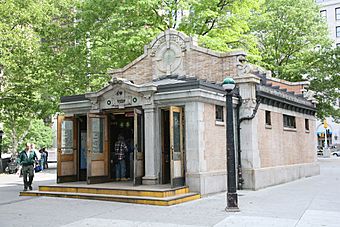
Station headhouse on Battery Park dates to 1905
|
|||||||||||||
| Built | 1905 | ||||||||||||
| Architect | Heins & LaFarge | ||||||||||||
| MPS | Interborough Rapid Transit Subway Control Houses TR | ||||||||||||
| NRHP reference No. | 80002669 | ||||||||||||
| Significant dates | |||||||||||||
| Added to NRHP | May 6, 1980 | ||||||||||||
The Bowling Green subway station is a busy stop on the IRT Lexington Avenue Line in New York City. It is located in the Financial District of Manhattan, right near Bowling Green Park and Battery Park. This station is served by the 4 train all the time and the 5 train most of the time.
The station first opened in 1905. It was part of the very first subway line built by the Interborough Rapid Transit (IRT). Over the years, the station has changed a lot to handle more passengers. It even had a special shuttle train that ran to South Ferry until 1977.
Today, Bowling Green station has three platforms. Two of them are in use, and one is no longer used. The station also has a historic building called a control house in Battery Park. This building was built in 1905 and is now a protected landmark. The station is also accessible for people with disabilities, thanks to elevators added in 2007.
Contents
History of the Bowling Green Station
Building the First Subway Line
Plans for New York City's first subway line began in 1894. Engineers, led by William Barclay Parsons, designed the subway system. A company called Rapid Transit Construction Company signed a contract in 1900 to build and run the subway. They hired Heins & LaFarge to design the underground stations.
The Interborough Rapid Transit Company (IRT) was formed in 1902 to operate the subway. Soon after, plans were made to extend the subway south to South Ferry and then across the East River to Brooklyn. Construction for this extension began in November 1902.
The Bowling Green station officially opened on July 10, 1905. It originally had one main platform. There was an exit building in Battery Park and another entrance near Bowling Green Park. At first, all trains ended at South Ferry because the tunnel to Brooklyn wasn't ready yet.
Changes and Expansions
The Joralemon Street Tunnel to Brooklyn opened in 1908. Some trains started going to Brooklyn, but others still went to South Ferry. To make things better for Brooklyn riders, a shorter platform and an extra track were built at Bowling Green in 1909. This allowed a special two-car shuttle train to run to South Ferry during busy hours. This shuttle ran until 1977.
In 1910, the subway platforms were made longer to fit more trains. This helped increase the subway's capacity by 25 percent. The main platform at Bowling Green was extended by about 110 feet (34 meters). Later, in 1937, the platform was extended again to make it easier for trains to stop.
In the 1950s, more changes were made to help with crowding. A new station house was built in Bowling Green Park in 1959. Platforms at many stations, including Bowling Green, were extended to 525 feet (160 meters) to fit longer, ten-car trains.
Modern Renovation
In 1972, the station began a big renovation project. The goal was to double the station's capacity. This was needed because many new office buildings, like the World Trade Center, were being built nearby.
As part of the renovation, a new platform was built for trains heading north. This helped reduce crowding on the old platform. New stairs and escalators were also added, along with a new exit near Bowling Green Park. The street called Bowling Green was closed and turned into a pedestrian area to make space for these changes.
During this renovation, the station's old mosaic tiles were replaced with bright orange tiles. The project finished in 1978 and cost $16.8 million. On February 13, 1977, the shuttle train to South Ferry stopped running. The platform and track it used were then closed off.
Recent Improvements
In 1999, MetroCard vending machines were installed at the station. In 2006, work began to make the station fully accessible for people with disabilities. This included replacing cobblestones with smooth granite, building an accessible path to Bowling Green Park, and adding a new glass roof over an entrance.
The elevators opened on July 9, 2007, making the station much easier to use for everyone. In 2020, the MTA tested a special hearing induction loop on the northbound platform. This helps passengers who are hard of hearing.
Station Layout
The Bowling Green station has two tracks and two platforms that are currently used by passengers. There is a center island platform for trains going downtown (southbound) and for trains that end their journey here. There is also a side platform for trains going uptown (northbound). A fence separates the island platform from the northbound track.
The walls and columns on the platforms have orange brick tiles and are painted beige. On the west side of the station, there's an old, unused island platform and track. This was once used by the shuttle train to South Ferry. It is now walled off.
Escalators and stairs connect both platforms to a lower level called the mezzanine. From here, you can switch between the uptown and downtown platforms. There are also elevators that connect the street level, the main northbound entrance, and the southbound platform, making the station accessible.
Track Connections
South of the station, the tracks split into two paths. One path goes into the Joralemon Street Tunnel and continues to Brooklyn. This is used by the 4 train and the 5 train during weekdays. The other path goes to the old, closed South Ferry inner loop station. The 5 train uses this path when it ends its journey at Bowling Green on weekends and late weekday evenings.
Station Exits
The Bowling Green station has several ways to enter and exit. These include street stairs, an elevator, escalators, and a historic building called the control house.
One entrance is in Bowling Green plaza, in front of the Alexander Hamilton U.S. Custom House. It has stairs and an escalator under a glass roof. Another entrance is on Battery Place, between Greenwich Street and Broadway.
At the very south end of the station, there's a staircase that leads to the historic control house.
The Control House
The Bowling Green IRT Control House is the original entrance building for the station. It's located in Battery Park, across from the Alexander Hamilton U.S. Custom House. Designed in 1905 by Heins & LaFarge, it's a beautiful building made of yellow brick and limestone.
This control house is a very important historical building. It is listed on the National Register of Historic Places and is a New York City designated landmark. While most subway entrances had simple steel and glass kiosks, important stations like Bowling Green had these special brick and stone control houses to help manage the flow of passengers.
Inside the control house, you'll find turnstiles at street level. A single staircase leads down to the very end of the island platform.
Station Artwork
The Bowling Green station features lightboxes that display changing artwork. Since 2018, the exhibition has been "Daily Voyage." It shows pictures taken by Glen DiCrocco of people riding the Staten Island Ferry every day. You can also see some of these photos on the MTA's Flickr account.
Nearby Places to See
The Bowling Green station is surrounded by many interesting buildings and places:
- The Alexander Hamilton U.S. Custom House is a beautiful historic building.
- The International Mercantile Marine Company Building at 1 Broadway.
- The Bowling Green Offices Building at 11 Broadway.
- The Cunard Building at 25 Broadway.
- The 26 Broadway, also known as the Standard Oil Company Building.
- The modern glass building at 2 Broadway.
Right outside the southern entrance is The Battery, another park with great views. You can also see the famous Charging Bull sculpture at the north end of Bowling Green Park, very close to the station.
Images for kids
See also
 In Spanish: Bowling Green (línea de la Avenida Lexington) para niños
In Spanish: Bowling Green (línea de la Avenida Lexington) para niños









